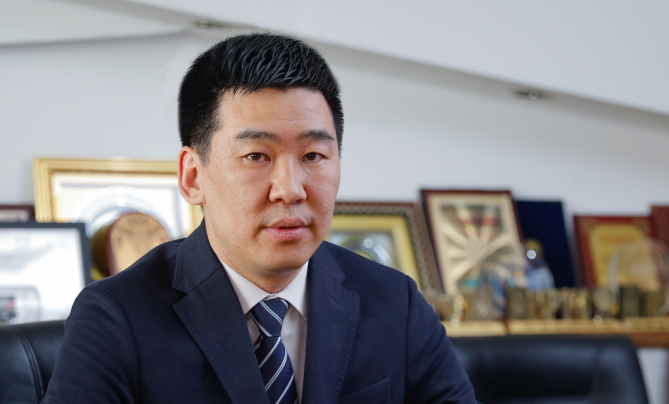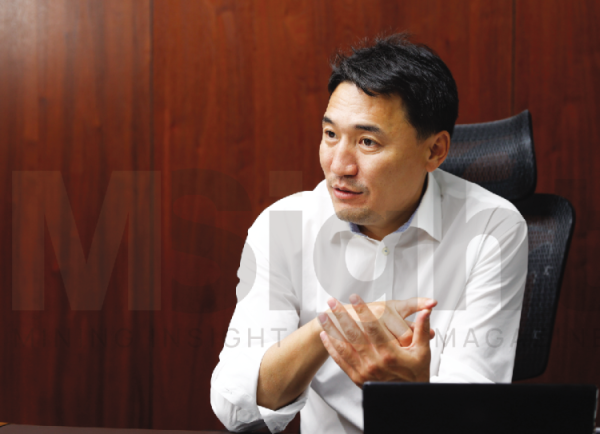 Construction of the Zuunbayan-Khangi railway is commencing this month to be completed within six months. Odjargal.E of Mining Insight Magazine spoke with Bayarjargal.B, General Director of Mongolian Trans Line LLC, a concessionaire, about the conditions, solutions, and economic calculations for how to build the railway in a short period.
Construction of the Zuunbayan-Khangi railway is commencing this month to be completed within six months. Odjargal.E of Mining Insight Magazine spoke with Bayarjargal.B, General Director of Mongolian Trans Line LLC, a concessionaire, about the conditions, solutions, and economic calculations for how to build the railway in a short period.First of all, can you tell us about your profession and experience?
I graduated from the Irkutsk State University of Roads and Transportation in Russia with a degree in railway transport management and freight management. After graduation, I took charge of transportation at Boldtumur Yeruu Gol LLC railway, one of Mongolia’s first private mining companies, from its founding to the present day. For over a decade, we have been responsible for loading and transporting bulk mining cargo in Mongolia, such as iron ore and coal.
What experience does “Mongolian Trans Line” LLC have in railway construction?
Our company has been operating for more than 10 years. In 2010, two stations with a total length of 115 km and three crossings were built in Yeruu soum of Selenge province. Also in 2019, we built the infrastructure of the Altanshiree Industrial Park, a branch of the Mongolian Oil Refinery Railway in Altanshiree soum of Dornogovi province, and the 15 km railway for the Iron Ore Wet Concentration, Coal Washing Plant, and Coke Processing Plant, Steel and Cast Iron Smelter, and a 2.2 km railway for oil and gas transshipment and coal loading and unloading facilities at the Zamyn-Uud port. We are currently responsible for all transportation services and the organization of these railways. Based on these experiences, we decided to build the Zuunbayan-Khangi railway, and our company entered into a concession agreement by Government Resolution No. 28 on January 12, 2022. Under the concession agreement, the construction of the railway has started on the terms of “design, construction, operation, and transfer”.
How many years will the company use the railway under the concession?
It will be used for 20 years and fully transferred to the state.
I take it that you are well-prepared for the railway construction as the construction is expected to be completed within 6 months.
Our engineers and technicians, who have experience in building local railways, will manage and monitor the process. In addition, subcontractors involved in the construction of the Tavan Tolgoi-Zuunbayan railway are involved in the construction. On the other hand, the railway construction area is in the steppe region, so it is relatively flat. We believe that it is possible to build the railway on time as long as the import of goods is not disrupted at the border. Currently, about 90 national subcontractors are operating along the border route. In total, more than 3,500 employees from 180 companies will be involved in the construction work. There are four units of the Ministry of Defense in the 50 km zone of the state border. As of today, the stripping work along the route has been completed and the technological road has been put into operation.
Excavation work is nearing completion and dirt work has begun. What are the features of railway technology?
The total length of the Zuunbayan-Khangi railway is 226.9 km. The slab is made of 100% reinforced concrete. There are two stations and six crossings. The station will be equipped with semi-automatic interlocking and alarm communication between cross ings. It has a capacity of 9 pairs of trains per day and a total capacity of 20 million tonnes of freight. It is a third-grade broad gauge railway with a 1520 mm distance between the two tracks.
What does the third grade mean?
There are three standards for railroads. It can be understood that the standard is chosen depending on the size and purpose of the cargo. The third grade is the freight railway. As the condition of the main railway line is steep to the south, it has been studied to transport freight by a locomotive with the latest capacity.
But 20 million tonnes of cargo would not be possible so early on, is it?
The Zuunbayan-Khangi railway will be commissioned partially in phases. Phase I of the railway will be commissioned with two stations and two crossings this year. 7-9 million tonnes of cargo will be transported with this. In the second phase, up to 15 million tonnes of cargo will be transported through the full commissioning of communications and other facilities and additional crossings by 2023. In Phase III, we will continue to increase the capacity of the railway to 20 million tonnes, and use its full capacity.
Is the partial commissioning related to financing?
The total cost of the railway is about USD 400 million. Most of this will be covered by the company. With this funding, the first 7-9 million tonnes of the railway will be commissioned. The remaining fund will be raised through the railway project. All types of financing, such as investment and bank loans, will be used to bring the railway to full capacity and expand further.
How will the broad gauge railway of Zuunbayan-Khangi connect with China’s narrow gauge railway network?
It is simple. It will have the same function as the Zamyn-UudErlian port. Our broad-gauge road leads to the port of Erlian, and China’s narrow-gauge road enters the port of Zamyn-Uud. The intersection covers 6 km on both sides. This is a 70-yearold scheme for the international transshipment of different gauge roads. Accordingly, the Zuunbayan-Khangi railway will enter the Chinese port of Mandal, and the narrow-gauge Mandal-Baotou railway will be connected to the Khangi port. The distance be tween the railway networks of the two countries will be 20 km.
Does this mean a transshipment terminal will be developed for it?
Yes. The Chinese side will build its terminal for receiving cargo. The Chinese side has already outlined its plans and is making preparations. The government has built a railway from Baotou to the port of Mandal as part of a five-year plan under the Belt and Road initiative. In 2017 and 2019, a joint commission of relevant organizations of the two countries reached an overall agreement on the border connection point. The railroad will be about 10 km from the Chinese port of Mandal. The government is currently working on finalizing the negotiation. Our company is also in regular contact with the management of Mandal port and is exchanging opinions.
Will mining raw materials be the main export product for the Zuunbayan-Khangi railway?
The total capacity of the Zuunbayan-Khangi railway can be increased to 30-35 million tonnes. It is estimated that 15 million of the current capacity of 20 million tonnes will be made up of Tavan Tolgoi coal and other mining products from the region, and the remaining 5 million tonnes will be iron ore from the Darkhan-Selenge region, value-added goods from the Sainshand and Altanshiree industrial parks, and transit cargo. Mongolia aims to increase coal exports to 60 million tonnes per year. Previously, our country exported a maximum of 36.6 million tonnes of coal. The Zuunbayan-Khangi railway alone will step up coal exports by 15 million tonnes. As for transit cargo, Russia is interested in transiting 8 trains a day, and China is also interested in it, but the Ulaanbaatar Railway JV is currently capable of only four trains. Therefore, those four trains that cannot pass will be able to transport transit cargo on the Zuunbayan-Khangi railway.
Who will be responsible for the transportation and logistics of this railway?
Our company will be in charge of the management as the concessionaire.
The initial plan was to build the railway from Zuunbayan station to Khangi port. What was the reason for rerouting from the 112th km of the Tavan Tolgoi-Zuunbayan railway to Khangi?
Our company took into account several conditions when calculating this route. First, we brought it closer to Tavan Tolgoi deposits. From the Tavan Tolgoi deposit to Zuunbayan station, Export coal would have to be carried across 700 km on road from Tavan Tolgoi deposits to Zuunbayan station and then to the Hangi port, so we are saving 160 km from this long travel. Second, the railway will run 15 km from the Tsagaan Tsav groundwater deposit of Mandakh soum. This is the basin that was studied as a water source for the Tavan Tolgoi coal washing plant and the copper concentrator. Third, projects with mining licenses in the Gobi region will be the main export infrastructure for existing mines. For instance, the Tsagaansuvarga copper project, which is being prepared for production and export, is 40 km from the Zuunbayan-Khangi railway route. This means that the factory will be able to export its products directly through the Khangi port by building an intersection. Another advantage of the railway route is that it passes through Mandakh, Ulaanbadrakh, Khuvsgul, and Khatanbulag soums, all of which will be connected to the national network railway infrastructure. Therefore, it is important for the turnover of imported goods of local communities and businesses. In general, there are 6-8 large deposits with mining licenses in this region. Infrastructure will increase the value of deposits and projects, as well as create conditions for economic circulation. As of today, Elstei, Ailbayan, Ikh Gobi Energy, and Sor Gobi mines are exporting minerals by road via the Khangi port.
Will the Zuunbayan-Khangi railway be accessible to companies exporting coal by road through the Zamyn-Uud port?
Currently, the companies that you’ve mentioned are using heavy-duty trucks to transport coal that travels about 470 km on unpaved roads from the Tavan Tolgoi deposits across 6 soums of three provinces, and load them on a trail car at Choir, which will travel another 400 km through the Zamyn-Uud port to the export market. These companies will be able to use the Zuunbayan-Khangi railway to reduce transportation costs.
How far will Tavan Tolgoi coal be transported by rail to be exported through Khangi port?
It will be 22 km from the Tavan Tolgoi deposit to the railway, 303 km to Zuunbayan on railroads, and 226 km on the Zuunbayan-Khangi railway to enter the Khangi port. The advantage is that it will mostly be transported on the railroad. The distance from Khangi to Bautou is 262 km. As of now, the traveling distance is 416 km on the Tavan Tolgoi-Zuunbayan railway from the Tavan Tolgoi deposit, about 50 km on the Zuunbayan-Sainshand railway, and 235 km to the south to reach the ZamynUud port. After crossing the border, it goes another 645 km through Jining and Hohhot to the key market of Baotou. So it travels over 400 km longer within the territory of China. So the new route will save a portion of the cost and incorporate it into domestic produc tion, increasing the overall selling value at the border. Most importantly, the traveling time of freight transport will be minimized, while accelerating the country’s export turnover. This in itself is a significant advantage that will increase the competitiveness of Mongolian mining products. Mandal is a port in Baotou of Inner Mongolia that borders Khangi port. The stateowned Mandal-Bugat railway in this direction creates favorable conditions for shippers and consignees, even in terms of transportation tariffs.
What are the possible freight items that can be transported on the way back from Khangi?
Baotou and Jining are home to a wide range of industries, including construction materials, consumer electronics, mining machinery and equipment, mobile phones, and technology products. The Khangi-Mandal is the closest port in the region to Mongolia, so the returning train can transport everything from construction materials to consumer goods. This will also help reduce the current traffic congestion at the Zamyn-Uud port. In addition to the materials needed for many of the ongoing construction projects in our country, machinery and equipment will also be available at the Khangi port.
It seems the implementation of this railway project is heavily dependent on your company. How confident are you in making this project a reality on time?
It is a great responsibility for our company to be in charge of the Zuunbayan-Khangi railway development. On behalf of the private sector, our company is working hard to build and operate the railway using our funds during such a crucial moment in time. We are confident that this development will serve as a model project for public-private partnerships and collaborations.



























